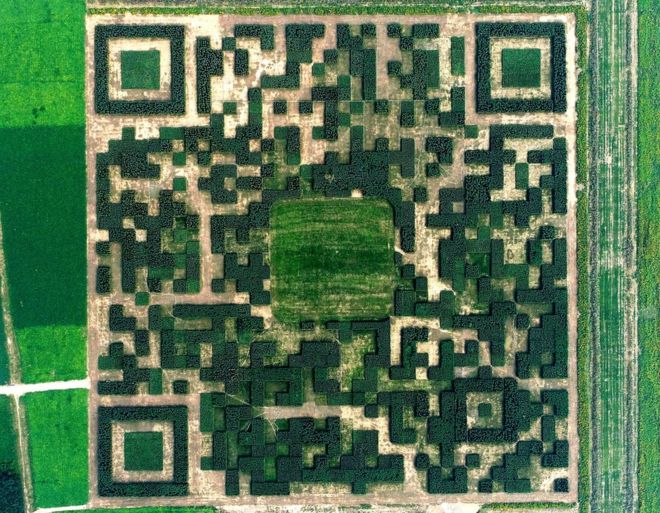From BBC News:
Chinese maze: Village makes giant tech code from trees
At first glance, it could be the courtly maze of an English
country manor - albeit with some rather large gaps.
But a tech-savvy eye will instantly see the green design for
what it is - a massive QR code. These
high-tech barcodes are hugely popular in China as a way to make cashless
payments on a smartphone.
Xilinshui village, in the northern Hebei province, has
created one from trees in a bid to raise its profile. The design was made from 130,000 Chinese
junipers, and can be scanned from above using a phone or tablet.
It is not clear how high above the trees you would have to
be to scan it - or how you might get there - but visitors who successfully
capture the code will be connected to the village's tourism account on WeChat,
a Chinese social media site.
The vast design measures 227m (744ft) along each side, and
the trees are between 80cm and 2.5m in height, the South China Morning Post
reports. Xilinshui was named "the
most beautiful village in Hebei" in 2015, and received a 1.1 million yuan
($168,000; £124,00) development grant from the province.
Some possible questions:
1) What typo is there in the article?
2) You can see this as being made up of square pixels. What is the side-length of each pixel?
3) How many juniper trees are there in each pixel?
4) What is the conversion factor between metres and feet?
5) Convert the heights of the trees to feet and inches.
6) What are the conversion factors between the currencies?
7) If they spent all of the development grant money on tress
how much was each one?
8) How long might it have taken to plant all of the trees?
Some answers:
1) Typo: “($168,000; £124,00) development grant” – it looks
as if a zero is missing from the sterling figure.
2) Side-length of each pixel: I count 37 pixels along each
edge, but if the empty border is included then it is 39 by 39. 227 metres divided by 37 is 6.1m, whereas
227m divided by 39 is 5.8m. Let’s say
6m.
3) Number of trees in a pixel: I counted part of it and then
scaled up – I got about 650 tree-filled pixels. This
means there are, on average, 200 trees per pixel.
4) What is the conversion factor between metres and feet? Remember there are 12 inches in a foot. 3.278 feet is 3 feet 3 inches.
5) 80cm is 2 feet 7 inches.
2.5m is 8 feet 2 inches.
6) Convert currencies: $1 = 6.55 yuan. £1 = $1.35 £1 = 8.87 yuan.
7) Cost of a tree:
8.46 yuan. About 95 pence.
8) How long to plant them:
If we assume one minute per tree (because they were very small when
planted) and an 8 hour day, five days per week, then it would take one person
54 weeks to plant the trees. Essentially
it is a year. If we have two people
working on this then we can divide the time required. If it takes longer than a minute to plant a
tree (which is likely!) then we will need to multiply.


